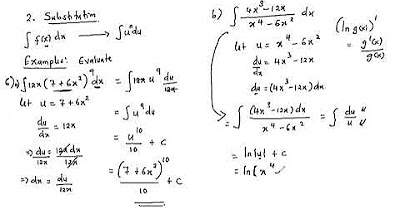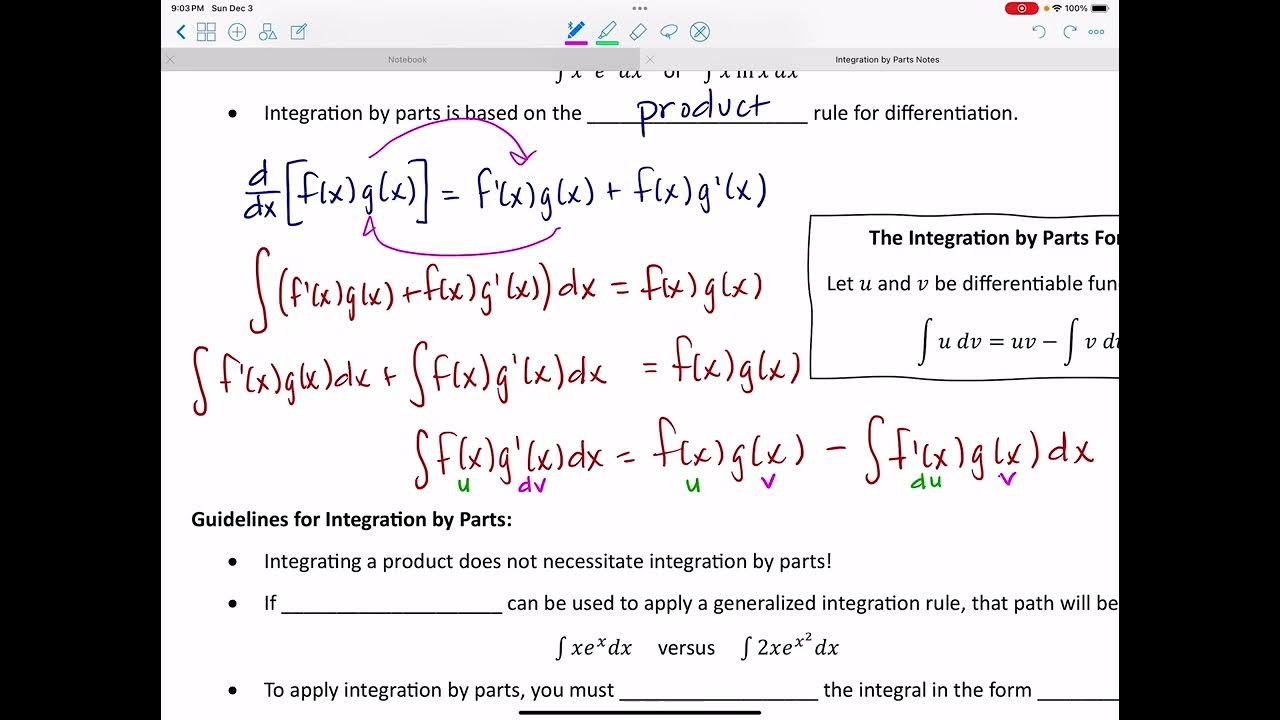Calc BC - Integration by Parts - Part 3
TLDRIn this instructional video, the speaker demonstrates the process of solving a complex integral using integration by parts, a technique that involves choosing a function whose antiderivative is easier to find. The example involves integrating a product of exponential and trigonometric functions. The speaker emphasizes the importance of persistence, as the integral may loop back on itself, requiring multiple rounds of integration by parts before converging to a solution. The final answer is presented as an expression involving exponential and sine functions, highlighting the common challenge of dealing with functions that do not have derivatives tending to zero.
Takeaways
- 📚 The example given is a unique case of integration by parts where neither function's derivative goes to zero.
- 🤔 The dilemma is choosing U and DV such that the antiderivative is easier to find, reflecting a strategic decision in the integration process.
- 🔍 The speaker opts for e^x as the antiderivative due to comfort with differentiating sin(x) over integrating cos(x).
- 📉 The integral setup involves I(x) = ∫(e^x * sin(x) - e^x * cos(x)) dx, showcasing the initial approach to the problem.
- 🔁 Integration by parts is applied again, leading to a recursive integral that resembles the original problem.
- 🔄 The process involves recognizing when the integral loops back on itself, which is a sign to look for a solution within the problem's structure.
- 📝 The speaker makes a mistake in the process but corrects it, emphasizing the importance of careful calculation and checking.
- 🧩 The solution involves breaking down the integral into parts and recognizing when the integral repeats itself, leading to a solvable form.
- 🔑 The final answer is derived by isolating the original integral, leading to an expression involving e^x * sin(x) - e^x * cos(x).
- 🔢 The integral can be simplified by factoring out e^x and dividing by 2, followed by adding the constant of integration, C.
- 🚀 The example serves as a reminder to persevere with integration by parts, even when the process seems to loop, as it will eventually resolve.
Q & A
What is the main challenge faced in the fifth example of the script?
-The main challenge is that there is no function whose derivative goes to zero, making it difficult to choose the functions for U and DV in integration by parts.
Why does the instructor prefer to choose e^x over sin(x) for the antiderivative?
-The instructor prefers e^x because it is easier to find the antiderivative of e^x compared to sin(x), and they feel more comfortable taking derivatives of sin(x) than finding antiderivatives.
What is the initial choice for U and DV in the integration by parts process described in the script?
-The initial choice is U = e^x and DV = sin(x)dx, leading to an integral I(x) = ∫(e^x * sin(x) - ∫(e^x * cos(x)dx)dx).
What happens when the integration by parts is performed again in the script?
-The process leads to an expression that includes the original integral, which indicates a loop in the integration by parts process.
How does the instructor handle the loop in the integration by parts?
-The instructor recognizes the loop and simplifies the expression by subtracting the integral of e^x * sin(x) from the original integral, eventually solving for I(x).
What is the final expression for the integral of e^x * sin(x)?
-The final expression is e^x * sin(x) - e^x * cos(x), which can be factored and simplified further.
Why is it important to be aware of the possibility of loops in integration by parts?
-Loops can occur when neither function has a derivative that goes to zero, and being aware of this can help in persisting through multiple rounds of integration by parts until the expression simplifies.
What is the significance of the choice of U and DV in the integration by parts process?
-The choice of U and DV affects the ease of finding the antiderivative and the complexity of the integration process, making it crucial to choose functions that simplify the calculations.
How does the instructor ensure consistency in the expression during the integration by parts?
-The instructor carefully tracks the expressions and simplifies them step by step, ensuring that the final answer is consistent and correct.
What is the final step in solving the integral after recognizing the loop?
-The final step is to subtract the integral of e^x * sin(x) from the original integral, leading to the simplified expression e^x * sin(x) - e^x * cos(x) + C.
Outlines
🤔 Facing a Dilemma in Integration by Parts
This paragraph discusses a situation in integration by parts where neither function has a derivative that goes to zero. The author explains their approach to choosing which part to differentiate and which to integrate, opting for the part where finding the antiderivative is easier.
🔄 Integration by Parts Loop
Here, the author shows the initial steps of solving the integral by parts. They choose their parts and perform the integration, resulting in another integral that also requires integration by parts. This demonstrates a loop where the process repeats.
🔀 Second Round of Integration by Parts
The author continues with the second iteration of integration by parts. They carefully select parts again, simplify the expressions, and manage the sign changes during integration. This step prepares the groundwork for solving the integral fully.
🔁 Recognizing the Integral Loop
The author points out that the integral has returned to its original form, minus itself. This realization leads to the key step of moving terms around to isolate the integral on one side of the equation, simplifying the problem significantly.
✅ Solving and Final Answer
In this final section, the author solves for the integral, recognizing the loop and dividing both sides by 2 to get the solution. They provide the final answer and highlight the importance of persistence when dealing with integrals that loop back on themselves.
💡 Key Takeaways
The conclusion emphasizes that integrals requiring multiple rounds of integration by parts are common, and persistence is key. The author reassures the audience that recognizing the loop and carefully working through the steps will eventually lead to the solution.
Mindmap
Keywords
💡Integration by Parts
💡Antiderivative
💡Derivative
💡Dilemma
💡E^x
💡Sine Function
💡Cosine Function
💡Looping on Itself
💡Consistency
💡Factoring
💡Plus C
Highlights
Introduction of a fifth example with a unique dilemma in choosing U and DV for integration by parts.
The challenge of not having a function whose derivative goes to zero in the integration process.
The strategy of choosing a function for which the antiderivative is easier to find.
Preference for finding the antiderivative of e^x over sine, due to familiarity with differentiation.
Choosing cosine v as the function to integrate, resulting in an integral of e^x sine of x.
The integral is expressed as I(x) equals e^x sine of x minus the integral of e^x cosine of x dx.
Engaging in another round of integration by parts with u as cosine of x and dv as e^x dx.
The integral simplifies to I equals e^x sine of x minus the quantity of negative sine of x times e^x.
Further simplification leads to I equals e^x sine of x minus e^x cosine of x minus the integral of e^x sine of x dx.
Realization that the integral has looped back to the original integral, indicating a recursive pattern.
The integral simplifies to I equals e^x sine of x minus e^x cosine of x, minus I.
The final answer is derived as the integral being e^x sine of x minus e^x cosine of x.
Mention of the possibility of factoring and adding a constant C at the end of the integral.
Highlighting the common occurrence of loops in integration when neither function has a derivative that goes to zero.
Encouragement to persist with integration by parts even if it appears to loop back on itself.
Acknowledgment that the problem is challenging but offers hope for a solution through persistence.
The importance of recognizing the recursive nature of certain integrals and the need for multiple rounds of integration by parts.
Transcripts
5.0 / 5 (0 votes)
Thanks for rating:





